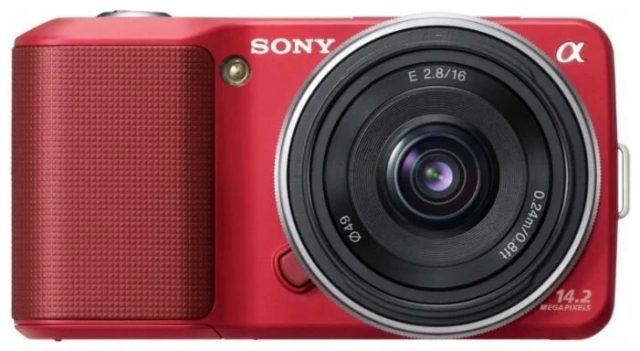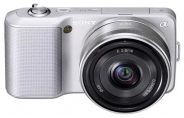Announced
Production status
System
Sony NEX-3
APS-C AF digital mirrorless camera • Discontinued
Specification
| Format: | |
| APS-C | |
Imaging sensor: | 23.5 × 15.6mm CMOS sensor |
Resolution: | 4592 × 3056 - 14 MP |
Crop factor: | 1.53x |
Sensor-shift image stabilization: | - |
| Sony E [18mm] | |
| Shutter: | |
Type: | Focal-plane |
Model: | Electronically controlled |
Speeds: | 30 - 1/4000 + B |
| Exposure: | |
Exposure metering: | Through-the-lens (TTL), open-aperture |
Exposure modes: | Programmed Auto |
| Aperture-priority Auto | |
| Shutter-priority Auto | |
| Manual | |
| Physical characteristics: | |
Weight: | 297g |
Dimensions: | 117.2x62.6x33.4mm |
Manufacturer description
Now photographers can enjoy the superlative picture quality and shooting responses prized by DSLR users in two beautifully compact new cameras that are brilliantly easy to use.
Joining the α family, the NEX-5 and NEX-3 team DSLR-quality imaging with the convenience of interchangeable lenses in a sleek new design that slips easily into a jacket pocket or bag. In contrast with conventional DSLR models, the ‘mirrorless’ construction shrinks the thickness of both cameras to just 24.2mm (NEX-5) at their slimmest point. As a luxurious extra refinement, the NEX-5 features a tough yet light-weight magnesium body, making it the world’s smallest and lightest interchangeable lens digital camera.
At the heart of both cameras is a newly-developed Exmor™ APS HD CMOS sensor with a resolution of 14.2 effective megapixels. Far larger than the sensor inside conventional compact cameras, its key to the extremely low image noise and creative defocus effects that are familiar to DSLR users.
Still and video image quality is further refined by the powerful BIONZ processor that ensures speedy DSLR-style shooting reflexes with quick, precise autofocus and minimal shutter lag. Both cameras can also capture fast-moving action with a high-speed burst of full-resolution images at up to 7fps (AF/AE fixed from first frame).
An elegant, uncluttered user interface – featuring a new ‘never get lost’ menu – makes the powerful creative possibilities of the NEX-5 and NEX-3 accessible to enthusiasts and step-up users alike. Shooting parameters are easily accessed via an intuitive control wheel and two soft keys. Turning the control dial, for example, allows depth of focus changes to be previewed ‘live’ on the LCD***, giving effortless control over beautiful, pro-style portraits. Further help for novice users is provided by on-screen shooting tips and a friendly help guide.
Images and camera settings are displayed on the big, bright 7.5cm (3”), Xtra Fine LCD with TruBlack technology that tilts up or down for comfortable viewing in any shooting position. The screen features an auto-brightness function for excellent visibility, even when you’re outdoors. TruBlack screen technology enables an even more vivid, high-contrast view of images and camera settings.
Compatibility with a wide range of interchangeable lenses dramatically expands the artistic possibilities of the E-mount camera system.
Ideal for everyday shooting, the low-profile E 16mm F/2.8 ‘pancake’ lens (SEL16F28) minimises bulk when the camera is being carried in a coat pocket. Its field of view can be boosted even further by the VCL-ECU1 Ultra Wide Converter and VCL-ECF1 Fisheye Converter that deliver high-definition optical performance in a sleek, co-ordinated design.
Featuring in-lens SteadyShot image stabilisation for clearer handheld images, the E 18-55mm F/3.5-5.6 zoom (SEL1855) is a perfect travel partner. The NEX-5 and NEX-3 are available in kit form with either lens, or as a double-lens kit that provides even greater shooting versatility. The NEX-5 can also be specified as a kit with the optional E 18-200 F/3.5-6.3 zoom that offers a powerful 11x magnification range plus Optical SteadyShot image stabilisation with Active Mode at wide angle for steadier movie shooting.
An optional LA-EA1 mount adaptor extends compatibility to the α family of 30 lenses and teleconverters, plus a huge range of other legacy A-mount lenses (Manual Focus only).
The NEX-5 and NEX-3 are also the first α cameras to offer the extra convenience of HD video recording. At the touch of a dedicated Movie REC button, the NEX-3 shoots HD video with stereo sound as compact MPEG4 files that are ideal for PC storage and web sharing. Full HD (1920 x 1080i) video captured by the NEX-5 as high-quality AVCHD files can be enjoyed on a connected HD television. As an option, the smart accessory terminal on both cameras accepts the compact ECM-SST1 Stereo Microphone that captures a high-quality soundtrack for your HD videos.
The NEX-5 and NEX-3 are the first α cameras featuring Sweep Panorama. Just press the shutter button and swing the camera side-to-side or up and down. A high-speed burst of frames is stitched together automatically to create detail-packed 23 megapixel panoramas with a 226 degree effective angle of view****. Panoramic files can also be enjoyed in stunning 3D on compatible BRAVIA™ 3D televisions.*****
As previously introduced on the DSLR-A550, Auto HDR has been further refined. The NEX-5 and NEX-3 can now shoot a high-speed burst of three images at different exposure values that are electronically combined in the camera. This produces a single High Dynamic Range image with extended highlight and shadow detail.
Both cameras come supplied with a super-compact clip-on flash that attaches via the smart accessory terminal when needed for low-light shooting. Other optional accessories include the FDA-SV1 Optical Viewfinder plus colour coordinated cases and shoulder straps.
The NEX-5 and NEX-3 system cameras from Sony are available from summer 2010.
Similar cameras (1)
APS-C • Auto focus • Digital • Mirrorless • Sony E mount
| Model | Shutter | Metering | Modes | Year |
|---|---|---|---|---|
| Hasselblad Lunar | E, 1/4000 | TTL • OA | PASM | 2012 ● |




